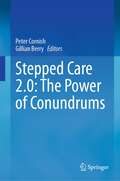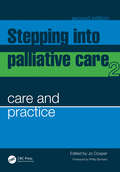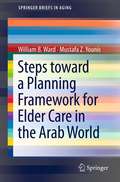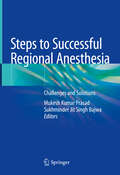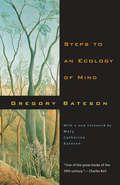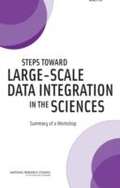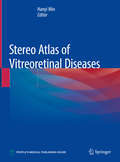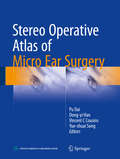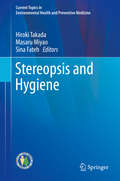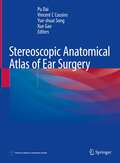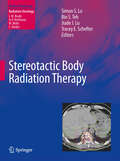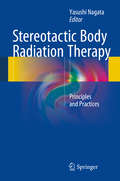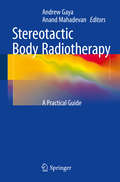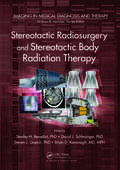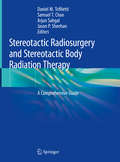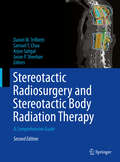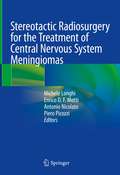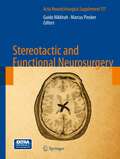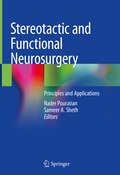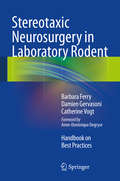- Table View
- List View
Stepped Care 2.0: A Paradigm Shift in Mental Health
by Peter CornishThis book is a primer on Stepped Care 2.0. It is the first book in a series of three. This primer addresses the increased demand for mental health care by supporting stakeholders (help-seekers, providers, and policy-makers) to collaborate in enhancing care outcomes through work that is both more meaningful and sustainable. Our current mental health system is organized to offer highly intensive psychiatric and psychological care. While undoubtedly effective, demand far exceeds the supply for such specialized programming. Many people seeking to improve their mental health do not need psychiatric medication or sophisticated psychotherapy. A typical help seeker needs basic support. For knee pain, a nurse or physician might first recommend icing and resting the knee, working to achieve a healthy weight, and introducing low impact exercise before considering specialist care. Unfortunately, there is no parallel continuum of care for mental health and wellness. As a result, a person seeking the most basic support must line up and wait for the specialist along with those who may have very severe and/or complex needs. Why are there no lower intensity options? One reason is fear and stigma. A thorough assessment by a specialist is considered best practice. After all, what if we miss signs of suicide or potential harm to others? A reasonable question on the surface; however, the premise is flawed. First, the risk of suicide, or threat to others, for those already seeking care, is low. Second, our technical capacity to predict on these threats is virtually nil. Finally, assessment in our current culture of fear tends to focus more on the identification of deficits (as opposed to functional capacities), leading to over-prescription of expensive remedies and lost opportunities for autonomy and self-management. Despite little evidence linking assessment to treatment outcomes, and no evidence supporting our capacity to detect risk for harm, we persist with lengthy intake assessments and automatic specialist referrals that delay care. Before providers and policy makers can feel comfortable letting go of risk assessment, however, they need to understand the forces underlying the risk paradigm that dominates our society and restricts creative solutions for supporting those in need.
Stepped Care 2.0: The Power of Conundrums
by Peter Cornish Gillian BerryStepped Care 2.0: A Paradigm Shift in Mental Health, by Dr Peter Cornish, made a compelling argument for why the existing mental health care system has consistently struggled to meet the needs of clients from all walks of life, and laid out key principles and guidelines for how the system could be changed. But what challenges are involved in putting these ideas into practice? Stepped Care 2.0: The Power of Conundrums features essays, interviews, and arguments from a wide range of contributors who have tried to do just that. The Power of Conundrums dives deep into the practical application of the Stepped Care 2.0 model (SC2.0), looking at the ways SC2.0 has succeeded, the difficulties administrators face when implementing it, and how it could be improved. Chapters touch on topics including: the evidence for stepped care, the way SC2.0 can be stymied by the Western cultural values that dominate mental healthcare, implementation science and SC2.0, the risk paradigm and SC2.0, the model’s one-at-a-time approach to therapy, what co-design means in an SC2.0 context, a case study on how implementing SC2.0 can go wrong, the understanding of recovery put forward by the model, and how SC2.0 can work for clients experiencing complex, persistent, or chronic mental health issues. Each chapter is followed by a reflection from Cornish, and the book concludes with a roundtable discussion about how SC2.0 can evolve to meet the challenges it faces. This text brings theory and practice together by including an updated version of Stepped Care 2.0: A Paradigm Shift in Mental Health, as well as the full text of Stepped Care 2.0: The Power of Conundrums.
Stepping into Palliative Care
by Jo CooperThe second edition of this highly successful text has been greatly expanded and updated, and is now available in two companion volumes. Stepping into Palliative Care 2 focuses on symptom management, emergencies, bereavement and spirituality. This practical guide with numerous examples, illustrations and thorough references, includes boxes, tables, figures, self-assessment questions, points for reflection and case studies to aid comprehension. The clear layout and straightforward approach is ideal for all those working in community care, including nurses, nursing students, doctors and social workers, and those already involved to some extent in palliative care.
Steps Toward a Planning Framework for Elder Care in the Arab World
by Mustafa Z. Younis William B. WardThis book reviews the elder care literature pertaining to the Arab world and proposes steps that can be taken to improve the health and quality of life of older people in this region. Organized in three main sections (Program Assessment, Program Planning, Conclusions and Recommendations), the book addresses such topics as developing a conceptual framework; Arab world elder demographics; quality of life issues; demand for services; training issues; training capacity and capabilities; and conclusions and recommendations for improving the health of older persons in the Arab world. While the countries of the Arab world have the advantage of a unified language and culture that can be used to expedite development of area-wide approaches to a system of elder care, the lack of economic and political unification (such as common market and open trade) along with institutionalized age discrimination (some Arab countries restrict hiring for government and private jobs to persons younger than 45) present barriers to improving the health of older people. In addition, modernization and ease of transportation have resulted in a heavy focus on Western-style fast food, with an accompanying increase in chronic diseases such as hypertension, cardiovascular disease, diabetes, and cancer.
Steps to Successful Regional Anesthesia: Challenges and Solutions
by Mukesh Kumar Prasad Sukhminder Jit Singh BajwaThe book covers regional anesthetic techniques, featuring flowcharts, illustrations, and necessary instruments. It provides tips and tricks for adequate analgesia during surgical procedures, particularly coverage of dermatomal sparing, failed spinal/epidural, and anatomical variations. The chapters cover various aspects of regional anesthesia, including block-related anatomy, troubleshooting barriers to successful blocks, use of a tourniquet and regional anaesthesia in extremes of age. It includes a step-by-step approach helping readers visualize the procedure in real time. The book is an invaluable resource for practicing doctors in peripheral and central locations and postgraduates.
Steps to an Ecology of Mind
by Gregory BatesonGregory Bateson was a philosopher, anthropologist, photographer, naturalist, and poet, as well as the husband and collaborator of Margaret Mead. With a new foreword by his daughter Mary Katherine Bateson, this classic anthology of his major work will continue to delight and inform generations of readers. "This collection amounts to a retrospective exhibition of a working life. . . . Bateson has come to this position during a career that carried him not only into anthropology, for which he was first trained, but into psychiatry, genetics, and communication theory. . . . He . . . examines the nature of the mind, seeing it not as a nebulous something, somehow lodged somewhere in the body of each man, but as a network of interactions relating the individual with his society and his species and with the universe at large. "—D. W. Harding, New York Review of Books "[Bateson's] view of the world, of science, of culture, and of man is vast and challenging. His efforts at synthesis are tantalizingly and cryptically suggestive. . . . This is a book we should all read and ponder. "—Roger Keesing, American Anthropologist Gregory Bateson (1904-1980) was the author of Naven and Mind and Nature.
Steps toward Large-Scale Data Integration in the Sciences: Summary of a Workshop
by National Research Council of the National AcademiesSteps Toward Large-Scale Data Integration in the Sciences summarizes a National Research Council (NRC) workshop to identify some of the major challenges that hinder large-scale data integration in the sciences and some of the technologies that could lead to solutions. The workshop was held August 19-20, 2009, in Washington, D.C. The workshop examined a collection of scientific research domains, with application experts explaining the issues in their disciplines and current best practices. This approach allowed the participants to gain insights about both commonalities and differences in the data integration challenges facing the various communities. In addition to hearing from research domain experts, the workshop also featured experts working on the cutting edge of techniques for handling data integration problems. This provided participants with insights on the current state of the art. The goals were to identify areas in which the emerging needs of research communities are not being addressed and to point to opportunities for addressing these needs through closer engagement between the affected communities and cutting-edge computer science.
Sterben, Tod und Trauer im OP: Für Lehre und Praxisanleitung in der ATA- und OTA-Ausbildung
by Ellen Rewer Anika DüpjohannDieses Buch richtet sich an Lehrende und Praxisanleitende in der ATA-OTA-Ausbildung sowie Tätige im OP und der Anästhesie. Die Autorinnen schaffen es, ein schwieriges Thema sensibel zu vermitteln und stellen konkrete Konzepte vor, wie das Thema u.a. in der Ausbildung integriert werden kann. So gelingt es, Betroffene individuell und situationsbezogen zu unterstützen, um mit dem Tod eines Patienten im OP oder der Anästhesie umgehen zu können.
Sterbende Menschen sprechen mit jungen Menschen: Eine Videoanalyse (Palliative Care und Forschung)
by Martin W. Schnell Christine Dunger Christian Schulz-QuachDie vorliegende Untersuchung zeigt, welche Sicht sterbende Menschen auf ihre Situation und auf die Welt anlässlich eines Gesprächs mit einem jungen Menschen haben und äußern. Die Gespräche sind als Video verfügbar und wurden durch eine Videoanalyse ausgewertet. Die Methode der Videoanalyse wird zudem vorgestellt und ausführlich reflektiert.
Stereo Atlas of Vitreoretinal Diseases
by Hanyi MinThis book introduces up-to-date knowledge of vitreal and retinal diseases with color fundus illustrations. The retinal layers of different lesions normally look like a single plane for junior doctors in Ophthalmology. With the help of the fundus camera, the stereo color images with different shooting angles are taken and the retina looks vivid and stereoscopic in the photograph. Although the technology of "deciphering" retina diseases is constantly advancing, the stereo fundus photography (SFP) is still indispensable, which can not only reveals the retina stereoscopically and comprehensively, but also has been the gold standard for certain diseases, such as glaucoma and retina angiomatous proliferation (RAP). Meanwhile, the equipment demands for SFP are not so high and can be easily promoted in the grass-roots hospitals. In this book, we carefully collected and organized more than 300 stereo color fundus images and angiography pictures of various vitreal and retinal diseases for readers to recognize the three dimensional features at first glance, such as retinal bleeding at different layers, optic disc change of glaucoma, macular diseases, tumors, RAP and polypoidal choroidal vasculopathy (PCV).
Stereo Operative Atlas of Micro Ear Surgery
by Pu Dai Dong-Yi Han Vincent C Cousins Yue-Shuai SongThis book introduces readers to modern micro ear surgery procedures employing 3-D methods. Divided into 5 chapters, it explores 43 micro ear surgery operations, while 418 pairs of stereoscopic images illustrate each procedure in 3-D detail. Using the operating microscope, which provides true stereo vision through its two-eye lens system, the authors present various micro ear surgeries, including mastoid and middle ear surgery, facial nerve surgery, inner ear surgery, and lateral skull base surgery. For each pair of stereoscopic images, readers can find the anatomic structures captured from two different angles, and will learn how to use stereoscopic 3-D methods to view the anatomic structures hidden deep in the temporal bone. As such, the book offers a valuable guide book and reference work for doctors specializing in otology, neurology and related fields.
Stereopsis and Hygiene (Current Topics in Environmental Health and Preventive Medicine)
by Hiroki Takada Masaru Miyao Sina FatehThis book outlines the principle and display methods of stereopsis, the biological effects of image viewing, and the effects on the human body, as well as its clinical significance. The authors also present the latest research findings and future prospects for stereopsis methods. In the field of medical care, the technique is useful for the 3-dimensional identification of lesions and affected regions; however, stereoscopic images can cause unpleasant symptoms including motion sickness, headache, and visual fatigue. With increasing opportunities for using the stereoscopic viewing technique in various other fields outside medicine, it is important to resolve the underlying issues of stereoscopic viewing and improve the diagnostic accuracy, safety of surgery and reduce the stress for physicians. Written by pioneering authors, Cutting Edge in Information Displays and Hygiene is a valuable resource for both new and established researchers and students seeking comprehensive information on stereoscopic imaging methods as well as professionals working in environmental/occupational health and health promotion.
Stereoscopic Anatomical Atlas of Ear Surgery
by Pu Dai Vincent C Cousins Yue-Shuai Song Xue GaoFeaturing a set of 3-D anatomic images of ear surgery based on innovative photographic devices, this book introduces anatomical details of ear surgery in the main areas of the temporal bone and lateral skull base. After overviewing basic anatomy of temporal bone and lateral skull base, the following 8 chapters covers step by step anatomic and surgical procedures of various ear surgeries, including transcanal approach, retroauricular approach, translabyrinthine approach, middle fossa approach, retrosigmoid approach, infratemporal fossa approach, and the stereoscopic virtual anatomy of the temporal bone. It is a practical and useful resource for residents in head and neck surgery, and related field.
Stereotactic Body Radiation Therapy
by Jiade J. Lu Bin S. Teh Simon S. Lo Tracey E. SchefterStereotactic body radiation therapy (SBRT) has emerged as an important innovative treatment for various primary and metastatic cancers. This book provides a comprehensive and up-to-date account of the physical/technological, biological, and clinical aspects of SBRT. It will serve as a detailed resource for this rapidly developing treatment modality. The organ sites covered include lung, liver, spine, pancreas, prostate, adrenal, head and neck, and female reproductive tract. Retrospective studies and prospective clinical trials on SBRT for various organ sites from around the world are examined, and toxicities and normal tissue constraints are discussed. This book features unique insights from world-renowned experts in SBRT from North America, Asia, and Europe. It will be necessary reading for radiation oncologists, radiation oncology residents and fellows, medical physicists, medical physics residents, medical oncologists, surgical oncologists, and cancer scientists.
Stereotactic Body Radiation Therapy
by Yasushi NagataThis book serves as a practical guide for the use of stereotactic body radiation therapy in clinics. On the basis of more than 10 years of clinical experience with lung cancer, liver cancer and other cancers, a remarkable volume of knowledge has been accumulated. At the same time, great progress in techniques has been achieved. Various new fixing apparatuses, new respiratory regulation techniques, new dose fractionation schedules and new image-guided radiation therapy machines have been developed. This book reviews the history of those developments and reports on various types of toxicities. Review of recent clinical studies is also included. The authors were key members of the JCOG 0403 clinical trials on stereotactic body radiation therapy (SBRT) for both inoperable and operableT1N0M0 primary lung cancer. Readers will learn of the superior outcomes obtained with SBRT for lung cancer and other cancers in terms of local control and toxicities. With its practical focus, this book will benefit radiation oncologists, medical physicists, medical dosimetrists, radiation therapists and senior nurses as well as medical oncologists and surgical oncologists who are interested in radiotherapy.
Stereotactic Body Radiation Therapy: Principles and Practices
by Yasushi NagataThe second edition of the well-received book updates the knowledge of clinical treatment, radiobiology, physics, and instrumentations to provide a comprehensive description of stereotactic body radiation therapy (SBRT). Clinical aspects include indications and prescriptions for diseases treated with SBRT and clinical trial details. The chapters associated with physics cover quality assurance, patient immobilization devices, respiratory motion management, and treatment planning. It also illustrates the latest devices and provides know-how for safe and reliable treatment that differs from conventionally fractionated radiotherapy. In this second edition, the future of SBRT using artificial intelligence in the post-COVID-19 world also discussed. Stereotactic Body Radiation Therapy 2nd Edition - Principles and Practices enrich the readers' understanding of patient-friendly cancer care. Radiation oncologists, medical physicists, medical dosimetrists, radiation therapists, senior nurses, medical oncologists, and surgical oncologists interested in radiotherapy will benefit from this practical guide. Since the last edition, there has been significant progress in the field, and the book renews the facts and evidence based on cutting-edge research.
Stereotactic Body Radiotherapy
by Andrew Gaya Anand MahadevanThis is a single, comprehensive handbook for clinical oncology trainees and consultants, covering the basic aspects of stereotactic radiotherapy systems and treatment.
Stereotactic Radiosurgery and Stereotactic Body Radiation Therapy (Imaging in Medical Diagnosis and Therapy)
by Stanley H. Benedict David J. Schlesinger Steven J. Goetsch Brian D. KavanaghWritten by internationally known experts in the field, Stereotactic Radiosurgery and Stereotactic Body Radiation Therapy examines one of the fastest-developing subspecialties within radiation oncology. These procedures deliver large doses of radiation in one to five sessions to a precisely determined target. Often these techniques have proven to be
Stereotactic Radiosurgery and Stereotactic Body Radiation Therapy: A Comprehensive Guide
by Jason P. Sheehan Arjun Sahgal Daniel M. Trifiletti Samuel T. ChaoThis book is a comprehensive review of stereotactic radiosurgery (SRS) and stereotactic body radiation therapy (SBRT): its physics, clinical evidence, indications, and future directions. The utilization of stereotactic radiosurgery (SRS) and stereotactic body radiation therapy (SBRT) is increasing internationally because of several factors. First, it offers patients a local treatment option that has demonstrated effectiveness similar to traditional surgery without the morbidity of general anesthesia and open surgical resection. Second, recent advancements in the quality of scientific evidence supporting a SRS or SBRT-containing approach in patients continues to evolve and demonstrate favorable disease-specific outcomes with little, if any, toxicity in various anatomic disease sites and for various conditions including cancer, benign tumors, and other psychiatric and neurologic conditions. Third, and most provocatively, is the notion that definitive local therapy (i.e. SRS or SBRT) in patients with cancer can boost the immune system to fight cancer in other sites throughout the body. While traditional medical knowledge would suggest that all patients with metastatic cancer are incurable, there is a mounting body of evidence that there is a subset of these patients that can be cured with definitive SRS or SBRT. This volume thus delves into each of these benefits and aspects of treatment, guiding physicians to the best treatment plan for their patients. Expert, international authors provide guidelines for SRS and SBRT use by clinicians. Chapters are divided into six main sections: Radiobiology of Radiosurgery and Stereotactic Body Radiation Therapy, Intracranial Radiosurgery Technique, Intracranial Radiosurgery by Indication, Stereotactic Body Radiation Therapy Technique, Stereotactic Body Radiation Therapy by Indication, The Future of Radiosurgery and SBRT. Overall physics are explained, as well as specific considerations for particular surgical tools (including the Leksell Gamma Knife and Accuray CyberKnife), techniques (including fractionated and charged particle radiosurgery), and anatomic sites (including brain metastases, pituitary tumors, and the prostate). Detailed images and charts enhance the chapters. This book provides physicians with a single, practical resource incorporating both of these broad categories of treatment, SRS and SBRT, and better defines the current role and the direction of radiosurgery.
Stereotactic Radiosurgery and Stereotactic Body Radiation Therapy: A Comprehensive Guide
by Jason P. Sheehan Arjun Sahgal Daniel M. Trifiletti Samuel T. ChaoThis new edition is a fully updated, comprehensive review of stereotactic radiosurgery (SRS) and stereotactic body radiation therapy (SBRT): its physics, clinical evidence, indications, and future directions. The utilization of stereotactic radiosurgery (SRS) and stereotactic body radiation therapy (SBRT) is increasing internationally because of several factors. First, it offers patients a local treatment option that has demonstrated effectiveness similar to traditional surgery without the morbidity of general anesthesia and open surgical resection. Second, recent advancements in the quality of scientific evidence supporting a SRS or SBRT-containing approach in patients continues to evolve and demonstrate favorable disease-specific outcomes with little, if any, toxicity in various anatomic disease sites and for various conditions including cancer, benign tumors, and other psychiatric and neurologic conditions. Third, and most provocatively, is the notion that definitive local therapy (i.e. SRS or SBRT) in patients with cancer can boost the immune system to fight cancer in other sites throughout the body. While traditional medical knowledge would suggest that all patients with metastatic cancer are incurable, there is a mounting body of evidence that there is a subset of these patients that can be cured with definitive SRS or SBRT. This volume thus delves into each of these benefits and aspects of treatment, guiding physicians to the best treatment plan for their patients. Expert, international authors provide guidelines for SRS and SBRT use by clinicians. Chapters are divided into six main sections: Radiobiology of Radiosurgery and Stereotactic Body Radiation Therapy, Intracranial Radiosurgery Technique, Intracranial Radiosurgery by Indication, Stereotactic Body Radiation Therapy Technique, Stereotactic Body Radiation Therapy by Indication, The Future of Radiosurgery and SBRT. Overall physics are explained, as well as specific considerations for particular surgical tools (including the Leksell Gamma Knife and Accuray CyberKnife), techniques (including fractionated and charged particle radiosurgery), and anatomic sites (including brain metastases, pituitary tumors, and the prostate). Since the first edition published, the field has grown significantly. There is now significant new data to support preoperative radiosurgery, increased indications in metastatic cancers, as well as integration with new drug therapies and imaging techniques. Each chapter is thus fully updated with the latest in medical advancements and new scientific research. Detailed images and charts enhance the chapters. This book provides physicians with a single, practical resource incorporating both of these broad categories of treatment, SRS and SBRT, and better defines the current role and the direction of radiosurgery.
Stereotactic Radiosurgery for the Treatment of Central Nervous System Meningiomas
by Michele Longhi Enrico D. F. Motti Antonio Nicolato Piero PicozziMeningiomas are the most frequently reported neuro-oncologic condition, accounting for 12% to 30% of all primary intracranial tumors. The first case of intracranial meningioma treated with stereotactic radiosurgery was reported by Backlund E-O in 1971. Since then, more than 200,000 meningiomas have been treated with stereotactic radiosurgery worldwide to date. The large number of patients treated using this method is due to the fact that meningiomas are frequently located in critical areas and microsurgery is often associated with severe and permanent neurological complications.This book discusses the advantages, risks and limits of stereotactic radiosurgery relating to all regions of interest for a neuroradiosurgical approach for the treatment of central nervous system meningiomas. Firstly, it presents an introduction focusing on the “state of the art”. It then discusses the physics, imaging, neurological and neuro-oncological issues in multidisciplinary management. Lastly, it features a summary of results, including the most recent published papers regarding all the locations involved in the stereotactic radiosurgery treatment as well as new approaches to meningiomas, with particular reference to the hypofrationated treatments. Intended for anyone involved in the neuroradiosurgical treatment of brain diseases, the book provides an up-to-date overview of the latest stereotactic radiosurgery treatment of central nervous system meningiomas.
Stereotactic and Functional Neurosurgery
by Marcus Pinsker Guido NikkhahSince its introduction about sixty years ago, stereotactic and functional neurosurgery has evolved into a fascinating and interdisciplinary endeavor that combines modern neurosurgery, neurobiology, and neuroimaging with innovative diagnostic and treatment strategies. In this collection, acknowledged experts from Europe and North and South America present their scientific and clinical experience in stereotactic and functional neurosurgery for movement disorders and brain tumors. The contributions present a wide range from the beginnings of human stereotactic neurosurgery to the most modern molecular and restorative strategies to treat diseases of the human nervous system. They clearly demonstrate that the discipline is still young and dynamic with alternative and sometimes competing strategies whose evaluation is underway. They also document that operative lesioning techniques such as thalamotomies, though still chosen under certain circumstances, have been succeeded by novel neuromodulation techniques such as deep brain stimulation in the great majority of clinical cases.
Stereotactic and Functional Neurosurgery: Principles and Applications
by Nader Pouratian Sameer A. ShethThis text presents a comprehensive and state-of the-art approach to stereotactic and functional neurosurgery. Overarching sections include achieving stereotactic precision, defining trajectories and targets, the biophysics of stereotactic therapies, diseases and targets, and the future of functional neurosurgery. Each section is designed to be inclusive of all relevant topics, serving as an unbiased resource to new clinicians in this field or established clinicians that are aiming to better understand complementary methods. Importantly, each section and the associated chapters can be used by basic and translational scientists as well as engineers and industry to better understand and deliver innovation to the field. Chapters within each section methodically analyze traditional and recently emerging concepts and techniques; address underlying principles with examples drawn from specific diseases and applications; and cover patient selection, target selection, available stereotactic methods, nuanced surgical methods, and clinical evidence across treatment options.Written by experts in each area, Stereotactic and Functional Neurosurgery is a definitive guide to the latest developments in stereotactic targeting, electrode implantation, surgical treatment of neurological and psychiatric disorders, the renaissance of stereotactic lesions, and the frontier of restorative neurosurgery for a variety of disorders that have no other therapeutic options.
Stereotaxic Neurosurgery in Laboratory Rodent
by Barbara Ferry Damien Gervasoni Catherine VogtStereotaxic neurosurgery in rodents is used by a variety of people working at research laboratories (research staff, technicians, students at animal facilities. . . ). The present handbook presents all the steps necessary to complete a stereotaxic neurosurgery protocol in accordance with current animal welfare guidelines. This book will guide surgeons step by step, from anesthesia to the post-surgery recovery procedures, including asepsis of the surgical tools and surgical zone, analgesia, correctly identifying the reference points on the skull and brain targets, etc. In keeping with the current international trends, the authors above all focus on the following points: the consideration of pain and how to best treat it depending on the type of surgery; and ensuring asepsis. This book will serve as an important reference work and valuable guidebook for the scientific community.
Sterile Compounding And Aseptic Technique: Concepts, Training, And Assessment For Pharmacy Technicians
by Lisa McCartneyThe newest addition to our Pharmacy Technicians product group is Sterile Compounding and Aseptic Technique: Concepts Training and Assessment for Pharmacy Technicians. This comprehensive program combines the concepts foundation of a textbook with the skills practice of a training manual. It includes clear step-by-step instructions and brief demonstration videos to help reinforce students' understanding of concepts and procedures. Offers calculations and critical-thinking exercises grounded in real-world applications; Emphasizes patient safety regulations during sterile preparation; Adheres to current USP 797 practice standards for the preparation of sterile compounds; Aligns with ASHP curriculum for accredited pharmacy technician programs; Packaged with DVD offering videos of lab procedures.

